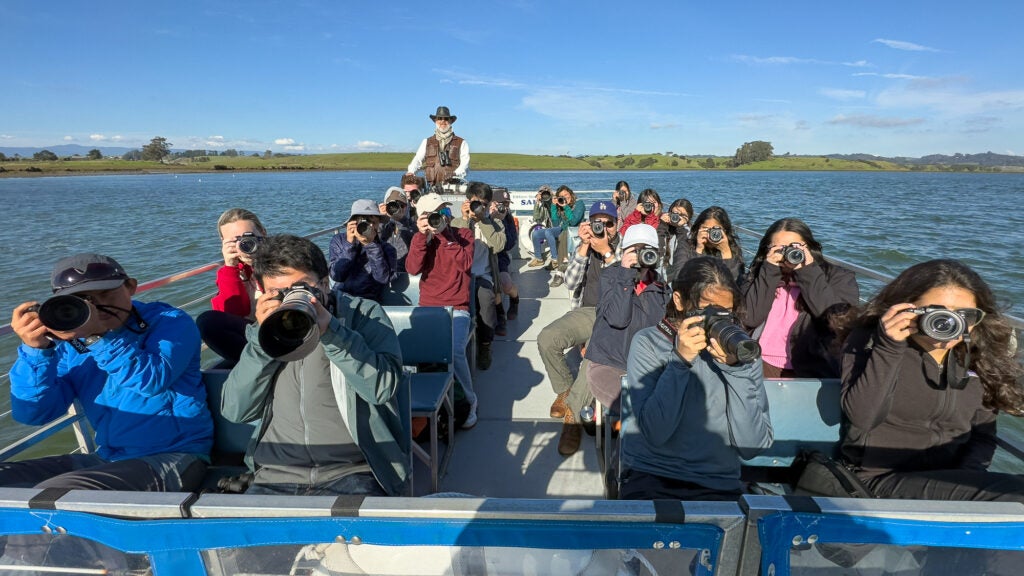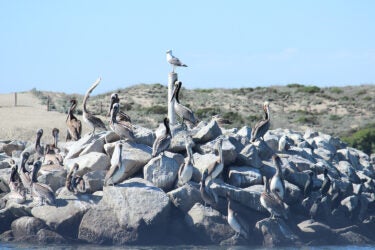Capturing the movement
Students in an introductory seminar on conservation photography learn that a camera can be a powerful tool for change.

Conservation Photography students show off their burgeoning camera skills. (Image credit: Susan McConnell)
A group of Stanford first-year students gathered around a dock on a sunny February day in Moss Landing Harbor, weighed down by cameras, lenses, and extra snacks. The group was listening to a short talk from their professor, Susan McConnell, who was giving them pointers on photographing wildlife from a moving boat.
“The shorter your focal length, the less you have to worry about blur,” said McConnell, the Susan B. Ford Professor, Emerita, and professor of biology in the School of Humanities and Sciences. “And so I think I’m going to use ‘shutter priority’ with my own camera.”
The students clambered onto a pontoon boat run by Elkhorn Slough Safaris and soon had their first wildlife sighting of the day: a California sea lion with a large fish in its mouth. A chorus of shutter sounds erupted from the group as the students rushed to photograph the sea lion before it slid back under the water.
These first-year students are enrolled in “Conservation Photography,” an Introductory Seminar course that covers the history, practice, and applications of photography focused on conservation and the environment. McConnell, a developmental neurobiologist by training, began teaching the course in 2010.
“I’ve always had a passion for wildlife and photography,” said McConnell. “And some of my own mentors were passionate and ardent conservationists.”
Students come to the course with varying levels of photography experience, but the syllabus covers more than how to use a camera. Over the quarter, the students learned about how photography has been used to influence social movements and causes throughout history, including during the Civil War, in the establishment of the National Park system, and during the movement to outlaw child labor in the early 1900s.
The course is structured around what McConnell calls the “Four A’s”: Appreciation, Analysis, Advocacy, and Activism, and students examine photography case studies related to those themes throughout the quarter. For instance, the class examined photographs related to the climate crisis when learning about activism photography.
“We need to fix this, and how are we going to use images to actually alter people’s behaviors?” said McConnell. “What kinds of images are going to personalize the fact that climate change is everywhere and it’s affecting people’s lives now?”
Putting new skills to work
This guided tour of Elkhorn Slough was a chance for students to test their photography skills in the field, and see coastal wildlife up close.
“I haven’t done a lot of photography,” said first-year student Megan Chiang, before the tour began. “Honestly, anything I can see would be awesome.”
Elkhorn Slough and Moss Landing provided a unique backdrop for McConnell’s course. In addition to the abundant wildlife, she encouraged the students to photograph the human activity surrounding the slough, where wildlife is thriving despite humanity’s influence on the area.
“There’s this incredible juxtaposition of nature and the harbor itself,” said McConnell. “As you go into the slough, there’s farmland, and issues of runoff, and then the power plant itself, which is a big player in the area.”
The boat was still in the harbor, but the students had already seen hordes of sea lions, flocks of marine birds, and a sea otter. Young male sea lions crashed into the water and playfully fought along the harbor’s docks as the tour guide taught the students about the history of Moss Landing and the creation of Elkhorn Slough, which is home to one of the nation’s largest marsh restorations.

Image credit: Madeline Reinsel

Image credit: Madeline Reinsel

Image credit: Susan McConnell

Image credit: Madeline Reinsel

Image credit: Madeline Reinsel

Image credit: Madeline Reinsel

Image credit: Madeline Reinsel

Image credit: Madeline Reinsel
First-year student Sam Warren didn’t have much photography experience before this quarter, but thought that the course might relate to his interest in environmental justice.
“I think photography has historically been a great way to further a lot of environmental justice causes,” said Warren. “And to bring communities that might be viewed as smaller by society to the front of those conversations.”
As the boat made its way out of the harbor, the students were greeted by more wildlife: pelicans and gulls perched on a made-made rock pile, and sea otters swam and hunted around the boat.
While most of the students were excited to see otters and seals, first-year student Emily Chu was happy to see so many birds on this trip.
“I’ve always loved birding specifically,” said Chu. “And I was never able to learn how to properly take photos of birds. I love spreading information about birds and bird conservation, so I wanted to learn to use photos to tell a story.”
Into the slough
As the boat continued into Elkhorn Slough, the students learned more about the area’s history of industry and conservation, as well as some fun facts (sea otters have favorite rocks that they use to smash open mollusks, and the animals may carry around the same rock for months or even years). The slough provides an excellent habitat for otters – in fact, sea otter populations may be reaching their carrying capacity in the area, showcasing the endangered species’ excellent local recovery, even amid the industrial backdrop.
At the end of the course, students generated a photo essay related to a local conservation or environmental issue. While many students chose to focus on wildlife on or near campus, others wrote about sustainability issues facing the Stanford community. Some students hope to apply their new photography skills to their other passions.
First-year student Antonio Vega said he’d never touched a camera before this class.
“I’m from the Sonoran Desert, which is one of the most biodiverse deserts in the world,” said Vega. “Nature is something that has always captivated me, especially pertaining to my culture. So I want to use a new skill that I can learn in this class to tell a story from the perspective of my people in a different way, capture nature in a different way, and be able to immerse myself in a different environment.”
The group continued to spot an abundance of wildlife throughout the tour, including harbor seals lounging on the muddy shores, sea lions with pups, and flocks of wading birds. At the end of the trip, the tour guide called out some statistics: the group had seen 52 sea otters, 67 harbor seals, 88 sea lions, and 29 species of birds.
Although they were thrilled to see so much wildlife, McConnell and her course assistant, Marina Luccioni, hope that students take away a larger message from the trip.
“Everyone in this class is so passionate and motivated, and it’s so hopeful to me to see such an awesome group of students who care about conservation from a lot of different angles,” said Luccioni, a graduate student in the Laboratory of Organismal Biology at Stanford. “We’ll see what students do to make their photos not just cute photos of otters eating, but something a little more meaningful.”